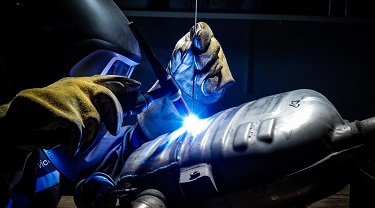In 2012, Craig Hodgins and his two partners at London, Ontario-based auto parts maker London Automotive and Manufacturing Ltd. (LA&M) had a difficult decision to make. After a challenging few years following the 2008 recession, the LA&M team succeeded in growing the company from $3 million in annual sales to over $10 million. General Motors (GM) had just recognized the company with a Supplier Quality Award for its high quality and on-time delivery of precision metal stampings, hinges and welded assemblies to its CAMI Automotive plant in Ingersoll, Ontario.
Around this time, Hodgins had what he describes as an unusually candid discussion with a buyer at GM about growing together further.
“She said flat out, ‘There’s no future if you have a straight Great Lakes footprint,’” recalls Hodgins. “’You need to be in either the Central U.S. or you need to be in Canada and either the Southern U.S. or Mexico. You need to attack from both ends or from the middle.’”
London Automotive took the leap and opened a plant in Querétaro, Mexico. Today, the company has annual sales of over $40 million between its two facilities. It’s also a GM Strategic Sourcing Partner (SSP), which ensures a steady flow of large contracts.
Like many people in the Canadian auto parts sector, Hodgins is breathing a sigh of relief that the renegotiation of the North American Free Trade Agreement (NAFTA) concluded with a positive resolution.
His company will continue to reap the benefits of being part of the highly integrated supply chain for auto parts that spans the three countries.
Hodgins is also looking for new opportunities to come from the new United States-Mexico-Canada Agreement (USMCA), once ratified. Changes to automotive rules of origin in the USMCA are designed to incentivize carmakers to do more sourcing from companies like his.
USMCA rules to require more North American content and production
Rules of origin are the criteria that determine if a good is eligible to receive preferential tariff treatment under a free trade agreement.
Rules of origin for vehicles and auto parts was one of the key issues in the NAFTA renegotiations. Rules outlined in the USMCA push for higher regional content and reduce incentives to make investment and sourcing decisions based on the availability of low-cost labour, which may be a boon for Ontario’s auto parts sector.
1. A higher regional value content requirement
Regional value content is the percentage of the value of a vehicle, part or component that was made in North America, including production in Canada, the U.S. or Mexico.
Under NAFTA, the regional value content requirement for autos was 62.5%. That is, 62.5% of the value of the vehicle had to be made in North America. Under the proposed USMCA, that requirement will rise to 75%.
2. Core parts
Under the USMCA, there will be stronger content requirements for core vehicle components such as engines and transmissions.
3. Steel and aluminum requirements
The USMCA outlines new rules for producers, who must source a minimum of 70% of steel and aluminum for vehicles and parts from within North America. It’s unclear yet whether the U.S. will lift the current tariffs it put on Canadian steel and aluminum in May.
4. Labour value content requirement
This new provision would require that 40-45% of a car producer’s activities, such as assembly, research and development, and information technology, be performed by workers earning a minimum of USD$16 per hour.
Hodgins points out that this last provision should help raise wages in Mexico, which is a good thing for Canada as well. “It helps even the playing field a bit more,” he says.
Hodgins is not concerned that London Automotive will have any difficulty meeting the new content requirements for its products.
“Hopefully it will drive some products that were sourced from Korea or China to be locally sourced, as well,” he explains.
Steel and aluminum sourcing remain factors under proposed USMCA
The proposed steel and aluminum requirements are a concern for Hodgins, however. U.S. tariffs on Canadian steel and aluminum introduced in May are still in place, as are the Canadian counter-tariffs.
“When I buy steel or aluminum offshore, that jeopardizes my content percentage because our production only adds so much value to it,” he says.
He has been able to find Canadian suppliers of steel at a comparable cost to what he previously sourced from U.S. suppliers. Canadian-made aluminum, however, is more expensive than U.S. aluminum. Hodgins says companies like his are using alternative sources, which could jeopardize content rules under the new USMCA.
“The tariffs force me to go offshore instead of getting my product from North America.”
New labour rules and low Canadian dollar make regional value compliance easier
On the other hand, Hodgins is less concerned about the proposed labour value requirement in the USMCA, even though his company operates a plant in Mexico.
London Automotive produces thousands of parts per hour, so the labour cost’s percentage of value in each part is minimal. He doesn’t anticipate an impact the product’s originating status.
By contrast, large Original Equipment Manufacturers (OEMs) like GM, and component integrators, like Magna, that perform complex assemblies of parts and vehicles, have higher labour costs per piece. The labour value content requirement could affect where OEMs decide to make investments, says Hodgins.
Hodgins says the low Canadian dollar over the last three years has encouraged his company to purchase its tooling from within Canada, rather than buying inputs from other parts of the global supply chain. This will help London Automotive more easily meet regional value content requirements under the proposed USMCA.
Another important achievement for Canada’s auto parts sector is in the U.S. Section 232 side letter. In May, the United States used Section 232 to impose tariffs of 25% on imports of Canadian steel and 10% on imports of Canadian aluminum on the grounds of national security. During the NAFTA renegotiations, people in Canada’s auto parts sector feared the U.S. would use Section 232 to place similar tariffs on Canadian-made vehicles and auto parts.
The side letter states that the U.S. will exempt Canada from any Section 232 action for up to 60 days once USMCA is ratified, during which time the two countries would seek a negotiated solution.
Significantly, if the U.S. imposes Section 232 measures, Canada will still have guaranteed duty-free access to the U.S. market for up to 2.6 million vehicles and USD$32.4 billion in auto parts. Both figures are comfortably above the level of recent exports to the U.S.
“We haven’t hit that volume in a long time,” observes Hodgins. “Unless there is some sort of major shift in the automotive sector in the way they look at sourcing, I just can’t see it making a difference at all.”
Want to learn more? Watch our webinar
With a new president and trilateral trade deal, Mexico is a market you need to look at.





